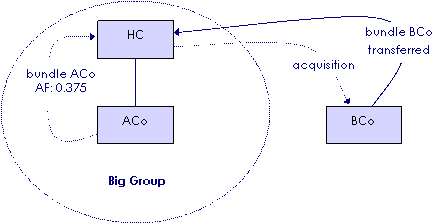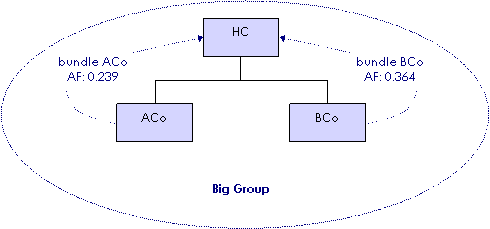Consolidation Reference Manual
You can still refer to the Consolidation reference manual for consolidation information that has not been impacted by changes in the legislation.
C3 Losses
C3-4 Worked example - loss utilisation
Adjusting the available fraction
C3-4-330 Adjusting available fraction - another loss entity joins the group
Description
Available fractions are adjusted to ensure they continue to approximate the proportion of the group's income that can be said to be generated by the relevant entity or group that transferred the loss.
The available fraction for each existing loss bundle in a consolidated group must be adjusted if another loss entity or group joins. This example shows how to:
- •
- adjust the available fraction for an existing loss bundle in the consolidated group, and
- •
- establish an available fraction for the new loss bundle.
- •
- loss bundles and calculating the available fraction → 'Treatment of losses', C3-1 ; 'Consolidation loss provisions', C3-2-110 (high-level worked example)
- •
- working out modified market value → 'Modified market value of a single joining entity', C3-4-110 (worked example)
- •
- market values → 'Market valuation guidelines', C4-1
Commentary
The adjustment to the available fraction for each existing loss bundle is required at the time losses in an incoming bundle or bundles are transferred to the head company. The head company has the option of cancelling the transfer of each incoming loss to avoid the adjustment. [F1]
The available fraction for each existing bundle of transferred losses is adjusted by multiplying it by the factor at item 3 in the table in subsection 707-320(2).
The factor is:
[ 1 - the total of the available fractions for all the new loss bundles transferred to the head company ]
Essentially, the adjustment is a 2-step process:
- •
- First, the available fraction for each incoming bundle needs to be established. The available fraction for each incoming bundle is either:
- -
- calculated for the first time under subsection 707-320(1), or
- -
- adjusted under item 1 in the table in subsection 707-320(2) if the losses are being transferred for a second or subsequent time → 'Adjusting available fraction - previously transferred losses are transferred again', C3-4-310
- •
- Second, the available fraction for each existing bundle in the group is adjusted under item 3 in the table in subsection 707-320(2).
Example
Facts
A consolidated group, 'Big Group', consists of head company HC and subsidiary member ACo. A loss made by ACo is transferred to HC when ACo joins the consolidated group. An available fraction of 0.375 is established for bundle ACo at the initial transfer time.
Big Group acquires another company, BCo, on 1 July 2004. BCo has a loss that is transferred to HC at the joining time.
This sequence of events is shown in Figure 1. Big Group must establish an available fraction for the incoming loss bundle (bundle BCo) and adjust the existing available fraction for its bundle of previously transferred losses (bundle ACo).
Figure 1: Big Group acquires BCo

Values are ascertained as at the time of transfer (1 July 2004) as follows:
- •
- modified market value of BCo = $400
- •
- adjusted market value of Big Group = $1,100
- (including the market value of BCo)
Calculation
Step 1 - Establish the available fraction for bundle BCo:
(400 / 1,100) = 0.364
Step 2 - Multiply the available fraction for bundle ACo by the factor:
0.375 * [ 1 - 0.364 ] = 0.239
The utilisation of losses in both bundles is subject to limits determined by reference to the available fraction method. Assuming no other adjustment events occur during the income year, the available fraction that applies to bundle ACo for the 2005 income year is 0.239 and the available fraction that applies to bundle BCo is 0.364.
The new consolidated structure just after the transfer time is shown in Figure 2.
Figure 2: Big Group just after transfer time

References
Income Tax Assessment Act 1997, subsections 707-320(1), 707-320(2); as amended by New Business Tax System (Consolidation) Act (No. 1) 2002 (No. 68 of 2002), Schedule 1
Explanatory Memorandum to the New Business Tax System (Consolidation) Bill (No. 1) 2002, Chapter 8
Current at 2 December 2002
The effect of cancellation is that the transfer is treated as if it had never occurred. Losses that are cancelled can never be used by any entity after the loss entity joins the group.
